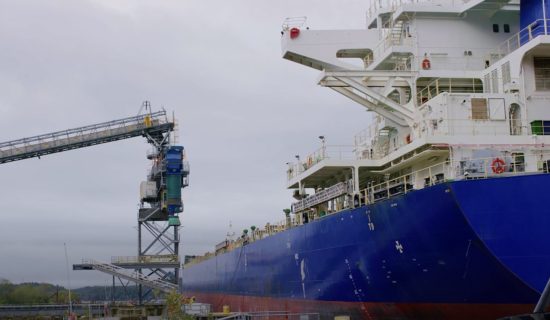Most of us know Canadian wood pellets are a sustainable, renewable product that is helping to mitigate climate change, but many don’t know how pellets are made, checked for quality and finally transported to customers around the world.
Power of Pellets: Production, Quality and Transportation is one of five new videos in The Power of Pellets series produced by the Wood Pellet Association of Canada. It brings all the pieces and partners together to tell this impressive story.
From the beginning, necessity has driven innovation and progress, according to the featured industry leaders who represent the span of sawmilling, wood pellet plants, transportation, and ports.
President of Skeena Sawmills and Skeena Bioenergy, located in northwest British Columbia, Roger Keery describes how when a number of pulp mills operating in the area shut down Skeena Bioenergy was created to take the sawmill residuals and turn them into pellets. “We knew we needed to find a home for them and so we looked at a bunch of alternatives and landed on building a pellet mill as a way to add value to our fibre.”
Russell Higdon, general manager of operations for Drax, tells the same story, but adds the goal was also to reduce “the greenhouse gas emissions that were created from beehive burners at sawmills.”
In B.C.’s Prince George Forest District, Drax’s biomass purchaser, Michael Thomas, RPF, explains how forest company’s normally burn slash piles to abate their fire hazard and also clear the area for spring planting. Instead of the piles being burnt, a contractor feeds the biomass into a horizontal grinder to generate a hog type material that will be transported to Meadowbank, the company’s closest pellet plant, significantly reducing greenhouse gas emissions that would have been otherwise released.
The superior quality of Canadian wood pellets depend on how the fibre is handled right from delivery to the sawmill through manufacturing and transportation to keep contamination out of the product.
Keery says the most important thing about wood fibre going into a pellet mill is to keep it clean, especially when that fibre is bark, sawdust and shavings.
“It is important in pellets that you control the raw material, so you control the properties of the finished pellet,” Keery continues. “Those products from our sawmills are separated into different piles, and then are blended in a formula before they go into the pellet plant. That formula allows us to control the characteristics of the pellet, which include its heat value, its ash content, its durability.”
Once produced, the pellets often face a complicated journey to market. Pellets are shipped by rail to either Vancouver or Prince Rupert, depending on the location of the pellet plant and the receiving customer. According to vice-president of industrial products for CN Rail, Kelly Levis, in 2000 they started moving 38 cars of wood pellets a year and are now moving over 28,000 cars each year.
B.C. owned and operated Fibreco Export Inc. is one of the largest wood biomass handling terminals in the world. Its strategic location on the north shore of Burrard Inlet in North Vancouver provides wood pellet producers with the advantage of efficient rail access within Canada and convenient marine access to international markets.
Fibreco Export Inc. president Megan Owen-Evans describes this critical gateway. “We’re really providing renewable and sustainable Canadian products to markets that otherwise wouldn’t have access to them.”
Shaun Stevenson, president and CEO of the Prince Rupert Port Authority agrees. The Port of Prince Rupert goes back over 100 years and ever since we’ve been moving cargo boat from the region. More than 20 years ago it went through a transformation to become a gateway for trade between continents in the Asia Pacific. “The Westview Wood Pellet Terminal has created a market access for growing biofuel exports out of northern B.C.,” he says.
Once a ship leaves Western terminal loaded with these Canadian wood pellets, it either crosses the Pacific Ocean to Asia or down to the Panama Canal and up towards Europe to supply markets with sustainable product for our customers – proud accomplishment for the entire sector. Watch the video below.
This article was originally published by Canadian Biomass, a national media brand providing coverage of the emerging biomass, bioenergy and bio-products markets. See CanadianBiomassMagazine.ca for more information.

